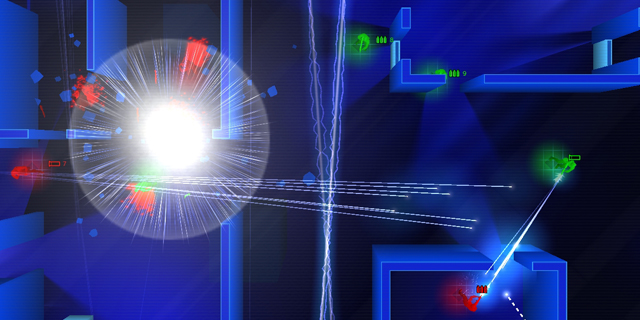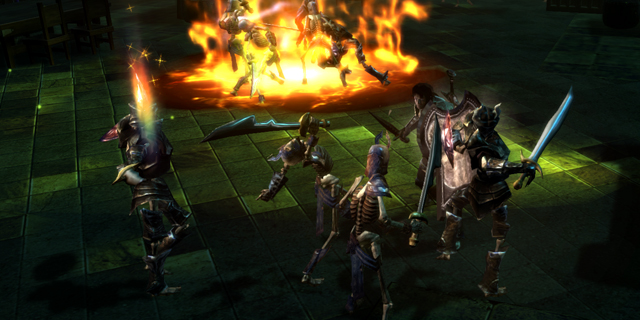“Welcome to the Wizardry Renaissance!” The Wizardry series, missing in action in the U.S. since 2001’s Wizardry 8 and Wizardry: Tale of the Forsaken Land, has always been a fan favorite for the old school RPG fans in the west since its inception in 1981. While Sir-Tech, the original developer behind the Wizardry series, has long since closed its doors, the series has lived on in Japan in the hands of multiple developers and fans keeping the series alive. Wizardry: Labyrinth of Lost Souls is a fine entry in the series, and serves as both a refresher for the old-time fan and a good introduction for newcomers to the series and the dungeon crawler genre. READ MORE
Reviews
Dungeon Siege III, the first in the series to appear on consoles, is all about the comfortable fun. It’s about co-op, looting, gaining experience and taking down hordes of enemies. These elements are reliably enjoyable to play through, and we haven’t seen a full retail take on the genre for a while now. READ MORE
 Do you love Chess’s analog nature? Chess by mail? A chessmaster playing 25 people all at once, rotating around tables? What about the board sitting on the living room table that has a move made on it by your opponent only once or twice a day? How about leaving the game for as long as you want, having as much time as you want to ponder a move, or simply being told when it’s your turn while you do something, anything else in between? A game like this would still be competitive, while exacting no demands on your time and done at the pace you want.
Do you love Chess’s analog nature? Chess by mail? A chessmaster playing 25 people all at once, rotating around tables? What about the board sitting on the living room table that has a move made on it by your opponent only once or twice a day? How about leaving the game for as long as you want, having as much time as you want to ponder a move, or simply being told when it’s your turn while you do something, anything else in between? A game like this would still be competitive, while exacting no demands on your time and done at the pace you want.
Arcade racing is a tough genre to create a game in. Car handling has to be easy without being automatic, tracks have to be challenging without being too punishing, and the whole package needs to be accessible. Sega Rally Online Arcade manages to be accessible, and they nail the handling, but the same track design and easy handling that help make the game approachable by all comers also make it too simple to keep coming back to when hard drives all over the landscape have copies of Dirt 2 and/or Burnout Paradise stored on them.
And that’s really Sega Rally Online Arcade’s biggest fault – playing it makes me want to play other games. The easy handling pushes me toward Sega’s own OutRun while the rally tracks push me toward Dirt 2, and the lack of damage modeling makes me want to start up Burnout Paradise and wreak some havoc with fully deformable cars, big ramps, and the ability to make my car blow up over and over again.
Discounting the fact that when I play SROA I immediately am drawn to other games, what Sega offers up here isn’t bad; it just feels like an arcade game from a few years ago. The options are pared down from a retail game, the graphics are flat, the sound work is generic, and the racing never feels frantic and dangerous like rally racing ought to. Different race surfaces change how the car handles, but while slamming into a mountainside to help navigate a turn slows you down right then it has no permanent effect on your car’s performance. And you can’t leave the track; fighting to stay on the track is one of the things that makes rally racing so interesting, and it’s just not here.
It is fun to run championship mode races where you start in 22nd place and have to fight your way to first over the course of three two-lap races in order to unlock a special one-on-one event. The selection of cars is nice (though I find myself unable to select cars that aren’t made by Subaru or Mitsubishi), but the number of tracks is very limited. There are five different locales, and each of them has two or three tracks. Variety is the spice of life, and for a racing game that means I expect plenty of places to learn every corner of to shave another second off of my lap time.
The cars handle well although the presentation takes some getting used to. The camera is fixed behind the car so no matter what is happening the car is facing forward while the world seems to turn around it. This takes some getting used to, and it never does feel quite right. Corners are easily navigated, and I didn’t need to really let off of the gas until I encountered U-turns, even when my navigator called out for hard turns. This makes sense, arcade racing is usually more about steering than speed control, and needing to seldom use the brake means that SROA maintains a good sense of speed while you’re playing.
SROA is strictly a middle of the road game. Nothing really stands out as horrible, but nothing really stands out as wonderful either. I never was able to find an online opponent, but online races look to function the same was as quick races against CPU opponents except (presumably) more challenging. If you have either another rally racer or another arcade racer, there’s no great need to add SROA to your collection, but if you don’t have any racers and don’t want to spend a lot of money, $10 isn’t a bad price for what you get here.
Pros: decent car selection, fun championship mode
Cons: makes me want to play other games, no car damage, cannot leave the track
L.A. Noire is a hard game to quantify. It is entirely unlike most games from Rockstar, or most other developers for that matter. It’s more of a gritty take on an interactive virtual novel than anything else. Whatever it is, though, it’s definitely worth the price of admission.
You play as Cole Phelps, a war hero and fledgling cop who’s trying to make the streets of 1940s Los Angeles safer for the people. Cole starts out as a beat cop, but by the end of the tutorial phase is promoted to traffic detective. The goal of the game is to rise through the ranks until you reach the top desk, Arson. Rarely will you concentrate on the goal though, because the gameplay is so enticing and draws you in so much.
L.A. Noire’s story is split into a number of individual cases that you’ll work at each desk, Traffic, Homicide, Vice, and Arson, with each one consisting of several phases. You’ll find yourself searching crime scenes for evidence, questioning witnesses, chasing down suspects on foot and by car, interrogating suspects, and even participating in a few shootouts. While each case plays out similarly, it never felt tedious or repetitive because the environment and cases are so well realized in the world that Team Bondi recreated. The gameplay really reminds me of a fully-fleshed out Phoenix Wright game, from the search for evidence to the interactions with those you talk to. When questioning a witness or suspect, you have the option to accept their statement as truth, doubt them, or outright accuse them of lying. Though, when accusing someone one of a lie, you have to have evidence to back up your assertion. Depending on how you treat each witness and suspect, the cases all play out in different ways. Getting interactions wrong could lead to cases taking longer than they otherwise would take, harmful endings for people who could have been saved, or arrests of the wrong suspect. The game takes all of this in stride and gives you a rating on each case. This gives L.A. Noire more replayability than you may think, since you can replay cases later in an attempt to do a better job or get a different ending.
To reduce the difficulty of the game for those who need it, Team Bondi included Intuition Points. These can be used to pinpoint evidence at a crime scene, get rid of one wrong response to a statement, or display the correct piece of evidence to use when accusing someone of lying. You get one each time you get enough experience to reach a new rank, of which there are 20. Thus, you can use a maximum of 20 hints in a single playthrough.
The graphics in L.A. Noire are phenomenal. The people are instantly recognizable by their faces, and facial expressions are amazingly accurate. The only gripe we have is that every woman looks to be in their mid-40s or 50s, even the children. The city itself is a nearly-faithful recreation of late 1940s downtown Los Angeles, and is enjoyable to just cruise around when you aren’t in a hurry to get to a crime scene. The soundtrack is vintage 1940s as well. (We did recognize a song or two also used in Fallout 3, amusingly.) As for the voice acting, the already-good work is helped a lot by the quality of the facial expressions accompanying the lines.
It may not be what most people expected out of a Rockstar-published title, but L.A. Noire is without a doubt one of our favorite games to date, and should be experienced by anyone.
Pros: Facial expressions are amazingly accurate, portrayal of 1940s LA is spot-on
Cons: Women all look old, no matter how old they are supposed to be





















